What?
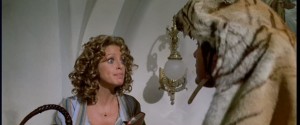 My theory has always been that Robert Altman fully developed his never-to-be-broken misanthropy while filming the conclusion of California Split. It was a spur of the moment decision on set, but who knows what Altman was going through personally at the time (he had a major problem with cocaine and alcohol)? George Segal and pal Elliott Gould play two degenerate gamblers and just as things turn around for them, Altman pulls the rug out, and has Segal, now gambling by himself with Gould only watching, win a big pot, only to walk away in silence, seemingly distraught at what his life has become.
My theory has always been that Robert Altman fully developed his never-to-be-broken misanthropy while filming the conclusion of California Split. It was a spur of the moment decision on set, but who knows what Altman was going through personally at the time (he had a major problem with cocaine and alcohol)? George Segal and pal Elliott Gould play two degenerate gamblers and just as things turn around for them, Altman pulls the rug out, and has Segal, now gambling by himself with Gould only watching, win a big pot, only to walk away in silence, seemingly distraught at what his life has become.
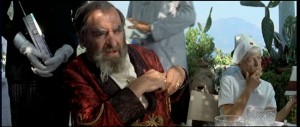 From that moment on, and in each film he made for the next 30 years (starting with Nashville), Altman’s attitude towards his characters was just pure disgust and hatred, going out of his way to make them look foolish. The source of this newly formed bile towards the human race is unclear, but it’s sure obvious he felt that way.
From that moment on, and in each film he made for the next 30 years (starting with Nashville), Altman’s attitude towards his characters was just pure disgust and hatred, going out of his way to make them look foolish. The source of this newly formed bile towards the human race is unclear, but it’s sure obvious he felt that way.
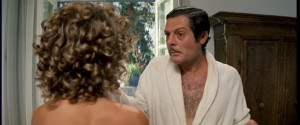 With Roman Polanski, his pain and suffering had an obvious root, that being the murder of his wife Sharon Tate by The Manson Family in 1969. While Polanski had made eerie and unsettling movies before his wife’s demise (Repulsion, Rosemary’s Baby), the films weren’t solely about the main character being repeatedly mentally and physically tortured, and his use of female leads wasn’t an excuse for exploitation of our sympathy, but rather a way to give us a better understanding of their situation.
With Roman Polanski, his pain and suffering had an obvious root, that being the murder of his wife Sharon Tate by The Manson Family in 1969. While Polanski had made eerie and unsettling movies before his wife’s demise (Repulsion, Rosemary’s Baby), the films weren’t solely about the main character being repeatedly mentally and physically tortured, and his use of female leads wasn’t an excuse for exploitation of our sympathy, but rather a way to give us a better understanding of their situation.
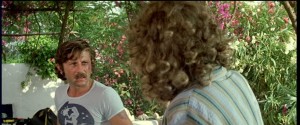 That changed after Tate died, and his follow-up film, the tremendously violent 1971 adaptation of Macbeth, has scenes that are truly just about rubbing our nose in the flowing blood, dirt, and death. Macbeth would be the more obvious example of excising his inner pain, since the violence was literally represented. But I’d argue that his 1972 film What?, is a much more sinister expression of loneliness and pain.
That changed after Tate died, and his follow-up film, the tremendously violent 1971 adaptation of Macbeth, has scenes that are truly just about rubbing our nose in the flowing blood, dirt, and death. Macbeth would be the more obvious example of excising his inner pain, since the violence was literally represented. But I’d argue that his 1972 film What?, is a much more sinister expression of loneliness and pain.
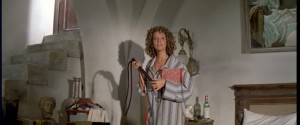 The reason for this is while hiding behind making an “adult” version of Alice in Wonderland, Polanski subjects his frequently nude and always naïve Alice, played by the 21 year-old Sydney Rome, to attempted rapes (which are supposed to be funny, but Polanski’s handle on the material is not as firm as Almodovar’s comic rape in Kika), dialogue so sexist and misogynistic as to almost play like parody, and a reliance on that old cliché that women always want sex, you just have to force them into it. Based on Polanski’s later real-life rape conviction of a young girl (the males in What? are all considerably older than Rome’s character), that would make a viewer understandably uncomfortable, but as a study of Polanski working through his standard themes of isolation and fear What? is a fascinating experiment.
The reason for this is while hiding behind making an “adult” version of Alice in Wonderland, Polanski subjects his frequently nude and always naïve Alice, played by the 21 year-old Sydney Rome, to attempted rapes (which are supposed to be funny, but Polanski’s handle on the material is not as firm as Almodovar’s comic rape in Kika), dialogue so sexist and misogynistic as to almost play like parody, and a reliance on that old cliché that women always want sex, you just have to force them into it. Based on Polanski’s later real-life rape conviction of a young girl (the males in What? are all considerably older than Rome’s character), that would make a viewer understandably uncomfortable, but as a study of Polanski working through his standard themes of isolation and fear What? is a fascinating experiment.
 One of the best ways that Polanski has learned to isolate his characters is to confine them all to one set (Death and the Maiden, The Tenant, Rosemary’s Baby), tightening the screws and elevating the tension, and also explaining why the characters are so mentally unbalanced. The difference is that What? is a comedy, and the very real awkward tension would seem inappropriate in other hands. Hell, it seems inappropriate in Polanski’s hands too, but for once he’s actually helped by the haphazardly designed feel of the film. What? has the slapped together improvisatory feel and distracting post-dubbing of a sloppy mumblecore film (like The Puffy Chair or Hannah Takes The Stairs), but it was shot on film and has some beautiful shots of the Italian countryside and it was shot in the 2.35 ratio, furthering the unrealness of the situation.
One of the best ways that Polanski has learned to isolate his characters is to confine them all to one set (Death and the Maiden, The Tenant, Rosemary’s Baby), tightening the screws and elevating the tension, and also explaining why the characters are so mentally unbalanced. The difference is that What? is a comedy, and the very real awkward tension would seem inappropriate in other hands. Hell, it seems inappropriate in Polanski’s hands too, but for once he’s actually helped by the haphazardly designed feel of the film. What? has the slapped together improvisatory feel and distracting post-dubbing of a sloppy mumblecore film (like The Puffy Chair or Hannah Takes The Stairs), but it was shot on film and has some beautiful shots of the Italian countryside and it was shot in the 2.35 ratio, furthering the unrealness of the situation.
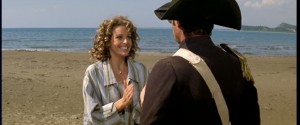 It’s this very unreality that aids What? in avoiding being absolutely appalling, despite his obvious contempt for the characters. Polanski further hammers the point home, in one of many meta moments, by having a horny painter, paint Rome’s leg blue, a visual reminder of the statues used in the pretentious movie that Fritz Lang is making for slick Hollywood-apologist Jack Palance in Jean-Luc Godard’s Contempt. What? constantly draws comparisons to Contempt, the title of the film is apparently derived from Contempt producer Carlo Ponti’s reaction to the film in the screening room.
It’s this very unreality that aids What? in avoiding being absolutely appalling, despite his obvious contempt for the characters. Polanski further hammers the point home, in one of many meta moments, by having a horny painter, paint Rome’s leg blue, a visual reminder of the statues used in the pretentious movie that Fritz Lang is making for slick Hollywood-apologist Jack Palance in Jean-Luc Godard’s Contempt. What? constantly draws comparisons to Contempt, the title of the film is apparently derived from Contempt producer Carlo Ponti’s reaction to the film in the screening room.
 Polanski shot What? at Ponti’s Italian villa, and his use of lax European sexual politics is one of the many distinctions the film has. [It’s odd that the “ugly American” tourists get off the lightest in terms of criticism.] While not as progressive as Woody Allen in Manhattan, Polanski’s attitude towards gays in What? is amusingly contradictory, with characters constantly throwing out epithets, and then immediately doing something that is stereotypically associated with gays. Marcello Mastroianni’s pencil-mustached pimp in a bathrobe proposes absolutely heinous things for Rome to do and others to do with her (shades of real life versions James Toback and Julian Schnabel), and his gay panic is just another addition to his piling list of personality deficiencies. [Though Marcello is involved in what is probably the first time the sexual kink of being a furry had been visualized in a mainstream film]. Polanski even gives himself a role, as the pervy Mosquito, hiding behind a porno mustache, and his is the purest expression of What?, that being anger expressed through sleaze.
Polanski shot What? at Ponti’s Italian villa, and his use of lax European sexual politics is one of the many distinctions the film has. [It’s odd that the “ugly American” tourists get off the lightest in terms of criticism.] While not as progressive as Woody Allen in Manhattan, Polanski’s attitude towards gays in What? is amusingly contradictory, with characters constantly throwing out epithets, and then immediately doing something that is stereotypically associated with gays. Marcello Mastroianni’s pencil-mustached pimp in a bathrobe proposes absolutely heinous things for Rome to do and others to do with her (shades of real life versions James Toback and Julian Schnabel), and his gay panic is just another addition to his piling list of personality deficiencies. [Though Marcello is involved in what is probably the first time the sexual kink of being a furry had been visualized in a mainstream film]. Polanski even gives himself a role, as the pervy Mosquito, hiding behind a porno mustache, and his is the purest expression of What?, that being anger expressed through sleaze.
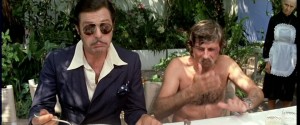 Repeatedly, men are stunned to find that Rome doesn’t want to have sex with them all the time, and are offended when she second guesses their invasions. By using Rome as a blank slate for all the men to project their women loathing tendencies (even a dying old man isn’t above abusing his situation for a peek), Polanski reinforces his point that no matter how hard they try to control it, vagina still rules the world.
Repeatedly, men are stunned to find that Rome doesn’t want to have sex with them all the time, and are offended when she second guesses their invasions. By using Rome as a blank slate for all the men to project their women loathing tendencies (even a dying old man isn’t above abusing his situation for a peek), Polanski reinforces his point that no matter how hard they try to control it, vagina still rules the world.



